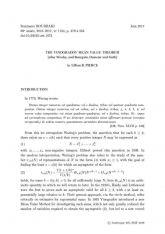Exposé Bourbaki 1134 : Le théorème de la valeur moyenne de Vinogradov (d'après Wooley, et Bourgain, Demeter et Guth)
Exposé Bourbaki 1134 : The Vinogradov Mean Value Theorem (after Wooley, and Bourgain, Demeter and Guth)

- Consulter un extrait
- Année : 2019
- Tome : 407
- Format : Électronique
- Langue de l'ouvrage :
Anglais - Class. Math. : 11L15, 11L07, 11P55
- Pages : 479-564
- DOI : 10.24033/ast.1072
En 1770, Waring a proposé d'étudier les représentations d'un entier comme somme de $s$ puissances $k$-ièmes. Au siècle passé, les raffinements de la méthode du cercle de Hardy-Littlewood ont permis d'obtenir une asymptotique du nombre de telles représentations, le but principal étant de réduire le nombre de termes. Une étape critique de la stratégie de Hardy-Littlewood requiert d'estimer une certaine somme exponentielle ; pendant les soixante-dix dernières années, cette question fut approchée par des versions de plus en plus sophistiquées du théorème de la valeur moyenne de Vinogradov. Récemment, la méthode de "congruence efficace" de Wooley a permis de s'approcher plus encore de la preuve de la conjecture principale. En abordant le problème sous l'angle du découplage $l^2$, Bourgain, Demeter et Guth ont finalement résolu cette conjecture. L'exposé présentera ces deux approches au théorème de la valeur moyenne de Vinogradov et exposera quelques applications aux problèmes de restriction discrète, au problème de Waring et à la fonction zêta de Riemann.

